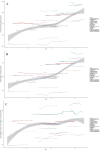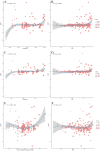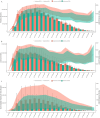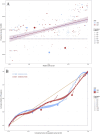Global trends and regional disparities in the burden of headache disorders, 1990-2021: a comprehensive analysis of the global burden of disease study
- PMID: 40538657
- PMCID: PMC12176582
- DOI: 10.3389/fneur.2025.1575705
Global trends and regional disparities in the burden of headache disorders, 1990-2021: a comprehensive analysis of the global burden of disease study
Abstract
Background: Headache disorders significantly impact health and functioning, yet studies on their global burden across all age groups are limited. This study utilizes data from the Global Burden of Disease (GBD) 2021 to investigate the global burden of headache disorders.
Methods: This analysis draws on GBD 2021 data, covering 204 countries and territories. We investigated the prevalence, incidence, and DALYs for headache disorders from 1990 to 2021, calculating Estimated Annual Percentage Change (EAPC) to analyze temporal trends. Additionally, decomposition analysis was used to evaluate the contributions of aging, population growth, and epidemiological changes. The slope index of inequality and concentration index were employed to assess inequalities in disease burden.
Results: From 1990 to 2021, the global prevalence of headache disorders increased significantly, reaching approximately 2.81 billion cases in 2021, a 57.16% increase from approximately 1.79 billion cases in 1990. During this period, the global Age-Standardized Prevalence Rate (ASPR) and Age-Standardized DALY Rate (ASDR) both showed gradual increases, while the Age-Standardized Incidence Rate (ASIR) remained stable, with EAPC values of 0.01, 0.04 and-0.0002, respectively. High Socio-demographic Index (SDI) regions exhibited the highest rates of ASPR, ASIR, and ASDR, whereas Middle SDI regions experienced the fastest growth, with EAPC values of 0.17, 0.17, and 0.18, respectively. The SDI exhibited significant positive correlations with the EAPC of ASPR (R = 0.18, p = 0.0093) and ASIR (R = 0.16, p = 0.027). Decomposition analysis identified population growth as the primary driver in regions with increasing disease burden. The slope index of inequality (SII) shows that disparities in ASPR, ASIR, and ASDR slightly increased from 7,648.13, 2,506.76, and 88.45 in 1990 to 7,851.55, 2,557.94, and 100.38 in 2021. In contrast, the concentration index (CI) in 2021 were 0.05, 0.05, and 0.04, showing no significant change from 1990.
Conclusion: Headache disorders continue to impose a growing burden globally, with marked regional and socio-economic disparities. Addressing these trends requires targeted public health interventions, particularly in high-burden and low-resource settings.
Keywords: decomposition analysis; estimated annual percentage change; global burden of disease; headache disorders; health inequality; socio-demographic index.
Copyright © 2025 Rui, Wu, Li and Zhang.
Conflict of interest statement
The authors declare that the research was conducted in the absence of any commercial or financial relationships that could be construed as a potential conflict of interest.
Figures







Similar articles
-
Burden of knee osteoarthritis in China and globally: 1990-2045.BMC Musculoskelet Disord. 2025 Jul 1;26(1):582. doi: 10.1186/s12891-025-08858-8. BMC Musculoskelet Disord. 2025. PMID: 40598022 Free PMC article.
-
Global, regional, and national burden of maternal disorders, 1990-2021: a systematic analysis from the global burden of disease study 2021.BMC Public Health. 2025 Jul 29;25(1):2576. doi: 10.1186/s12889-025-23814-w. BMC Public Health. 2025. PMID: 40730990 Free PMC article.
-
Trends and cross-country inequality in the global burden of nutritional deficiencies in children, with projections to 2035: results from the Global Burden of Disease study 2021.Front Nutr. 2025 Jul 29;12:1615593. doi: 10.3389/fnut.2025.1615593. eCollection 2025. Front Nutr. 2025. PMID: 40799517 Free PMC article.
-
National and subnational burden of brain and central nervous system cancers in China and global from 1990 to 2021: results from the global burden of disease study 2021.Arch Public Health. 2025 Jul 28;83(1):195. doi: 10.1186/s13690-025-01683-4. Arch Public Health. 2025. PMID: 40722045 Free PMC article.
-
Global burden and risk factors of musculoskeletal disorders among adolescents and young adults in 204 countries and territories, 1990-2019.Autoimmun Rev. 2023 Aug;22(8):103361. doi: 10.1016/j.autrev.2023.103361. Epub 2023 May 23. Autoimmun Rev. 2023. PMID: 37230312 Review.
References
-
- GBD 2021 Nervous System Disorders Collaborators . Global, regional, and national burden of disorders affecting the nervous system, 1990-2021: a systematic analysis for the global burden of disease study 2021. Lancet Neurol. (2024) 23:344–81. doi: 10.1016/S1474-4422(24)00038-3, PMID: - DOI - PMC - PubMed
-
- GBD 2021 Diseases and Injuries Collaborators . Global incidence, prevalence, years lived with disability (YLDs), disability-adjusted life-years (DALYs), and healthy life expectancy (HALE) for 371 diseases and injuries in 204 countries and territories and 811 subnational locations, 1990-2021: a systematic analysis for the global burden of disease study 2021. Lancet. (2024) 403:2133–61. doi: 10.1016/S0140-6736(24)00757-8, PMID: - DOI - PMC - PubMed
LinkOut - more resources
Full Text Sources

